How to Start a Husqvarna Chainsaw: A Beginner’s Guide to Safe & Easy Operation
- April 8, 2024
- 0 comment
Learn the right way to start and stop your Husqvarna chainsaw with our easy guide. Follow manufacturer-recommended steps to ensure safety and maintain your chainsaw’s optimal performance.
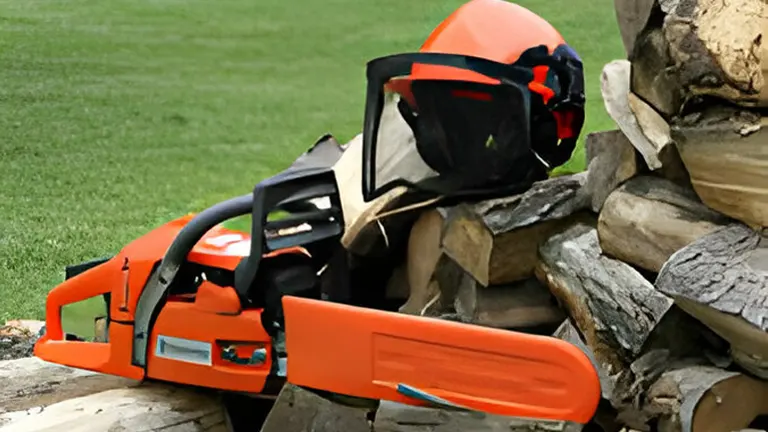
Getting your Husqvarna chainsaw going and shutting it down the right way is key to keeping both you and the chainsaw safe and in good shape. Following the steps the maker recommends for starting and stopping helps you stay safe and keeps the chainsaw working its best. Here’s an easy-to-follow guide to help you start and stop your chainsaw correctly:
How to Start a Husqvarna Chainsaw with a Cold Engine
1. Activate the Chain Brake
Ensure safety first by activating the chain brake. Push the front handguard forward to engage the brake, preventing the chain from moving during the start-up process.
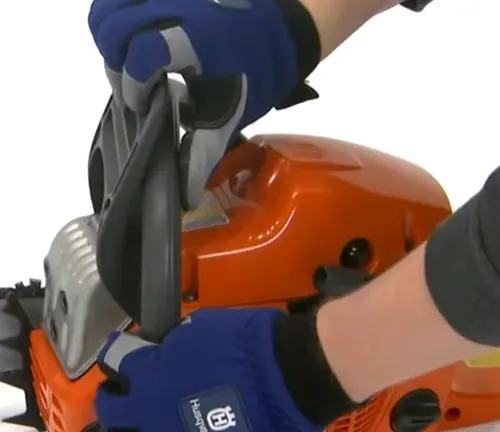
2. Set the Choke
To initiate a cold engine start, locate the choke control and pull it outwards. This action not only sets the choke but also moves the stop switch to the start position, preparing the engine for ignition.
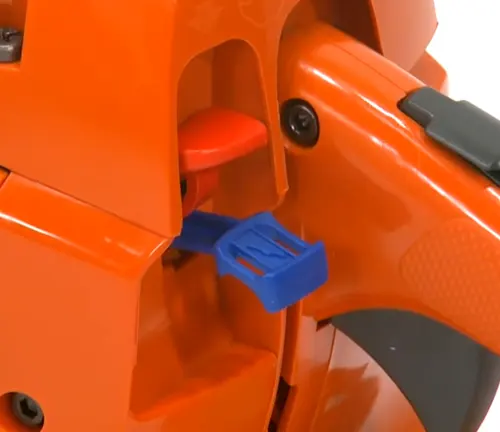
3. Prime the Fuel
Find the air purge bulb and press it five or six times. This primes the fuel system by drawing fuel into the carburetor. You’ll see the bulb fill with fuel, but it doesn’t need to be completely full to proceed.
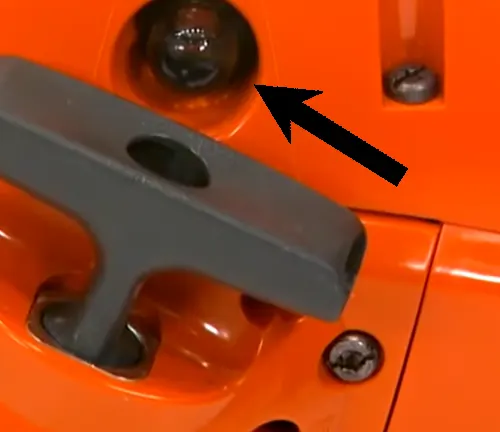
4. Use the Decompression Valve
Press the decompression valve, usually located near the engine. This step reduces the pressure in the cylinder, significantly easing the starting effort. The valve will automatically reset (close) once the engine starts, but it’s crucial to press it before each starting attempt.
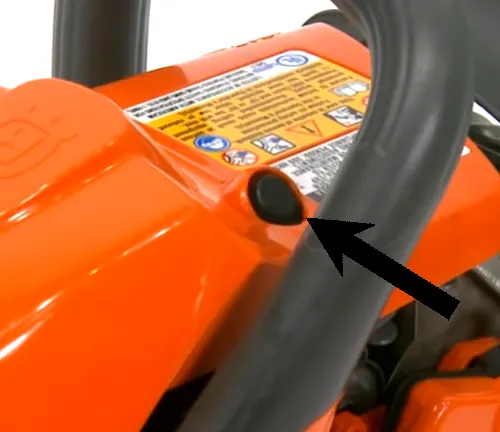
5. Pull the Starter Handle
Grip the starter handle with your right hand. Gently pull the starter cord until you feel a bit of resistance, indicating the piston is in the right position for a power stroke. Then, firmly pull the handle, ensuring not to extend the cord beyond 12 to 14 inches to avoid damaging the starter mechanism.
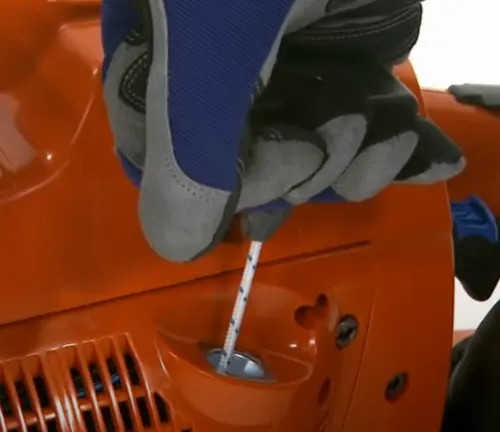
6. Attempt to Start the Engine
Now, with a quick and forceful motion, pull the starter handle until the engine fires up. Usually, the engine will make a noise or start running within two to three pulls, signaling that it’s ready to move to the next step of the starting process.
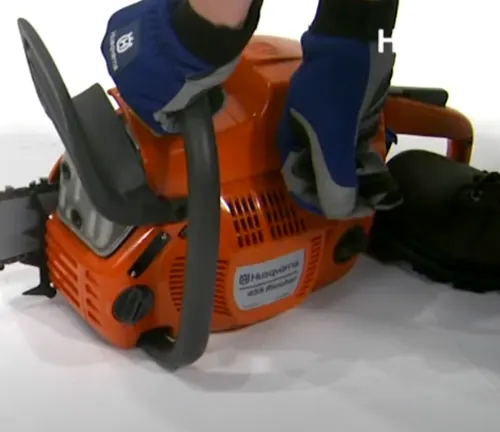
After the Engine Fires
1. Adjust the Choke and Decompression Valve
As soon as you hear the engine make the initial starting noise, indicating it has fired, promptly push in both the choke control and the decompression valve. This adjustment helps the engine transition from the starting phase to running mode.
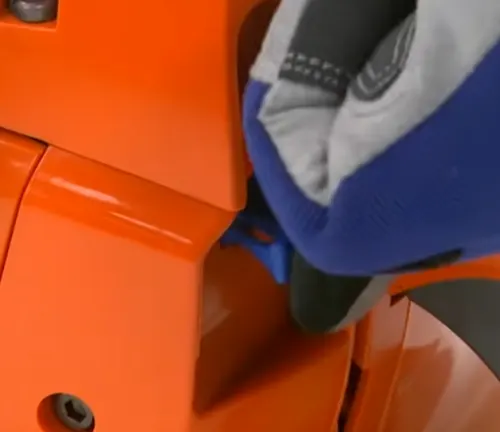
2. Start the Engine
Continue to pull the starter handle with the same firm, rapid pulls as before. This should be done until the engine transitions from the initial firing to fully running. It typically takes a few pulls after the initial fire for the engine to start running properly.
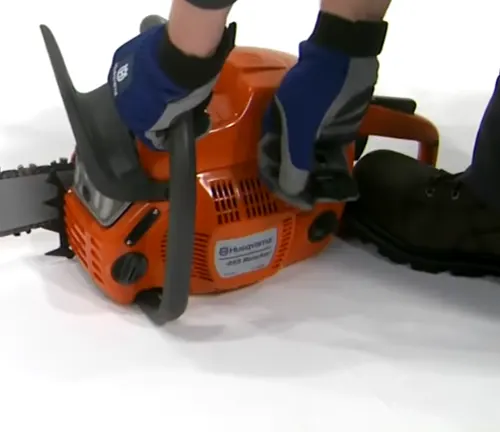
3. Set to Idle
Once the engine starts, it’s crucial to immediately set it to idle to prevent unnecessary stress on the chainsaw. Press the throttle lock to secure the throttle in a safe position, then gently squeeze the throttle trigger to increase the engine RPMs slightly. Quickly release the throttle trigger after a brief rev, which allows the engine to settle into an idle state. This process helps to stabilize the engine and ensures it is ready for operation without putting extra wear on the chainsaw’s clutch, drum, and brake band.

Starting with a Warm Engine
1. Adjust the Choke Control
When the engine is already warm, lightly pull out the choke control and then immediately push it back in. This action engages the fast idle control, preparing the chainsaw for a smooth restart without flooding the engine with excess fuel.
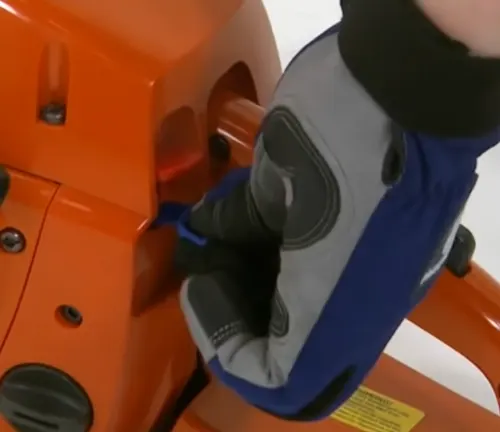
2. Prime the Fuel
Locate the air purge bulb and press it about six times or until you see the fuel level rise partially in the bulb. This step reintroduces fuel into the carburetor system, priming it for the start, especially if the chainsaw has been sitting idle for a short period.
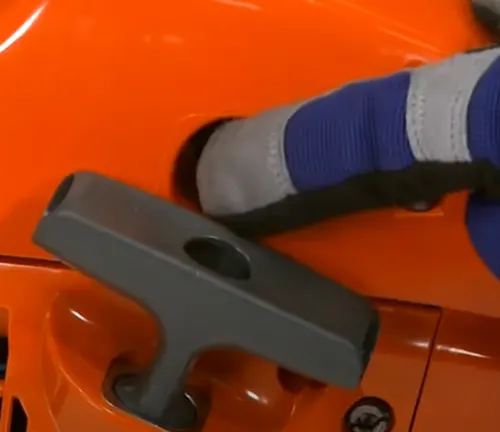
3. Use the Decompression Valve
Depress the decompression valve once more, which reduces the cylinder pressure and facilitates an easier start. It’s important to activate this valve before each attempt to start the engine, ensuring a smoother and more successful ignition process.
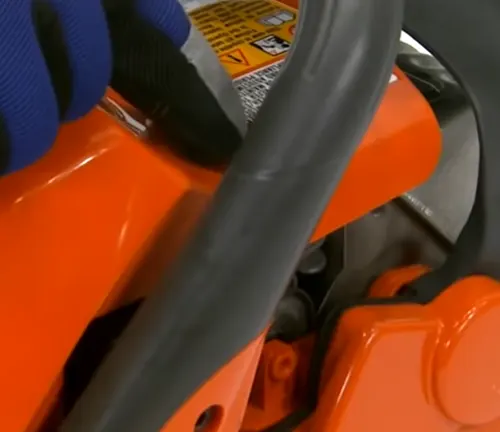
4. Pull the Starter Handle
Begin by gently pulling the starter cord until you feel a slight resistance, indicating the piston is in the optimal position for starting. Then, with a strong and swift motion, pull the starter cord to turn over the engine. This should be done with a firm hand but without excessive force to avoid overextending the cord.
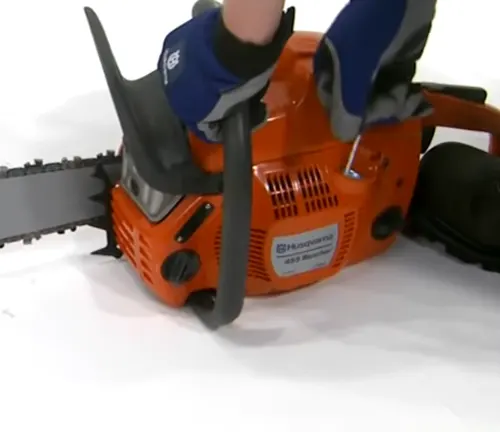
Before Revving the Engine
Before you increase the engine speed, it’s crucial to disengage the chain brake. This action releases the chain, allowing it to move freely when you rev the engine. Failing to disengage the brake can lead to excessive wear or damage to the chainsaw’s clutch and brake mechanism.
Stopping the Chainsaw
When you’re ready to stop the chainsaw, the process is straightforward — simply switch off the ignition. This action will cease the engine’s operation, safely bringing your chainsaw to a halt. Always ensure the chainsaw has fully stopped before setting it down or attempting maintenance or adjustments.
Troubleshooting Tips for Starting a Husqvarna Chainsaw
When you’re having trouble starting your Husqvarna chainsaw, here are some common problems and their solutions to consider:
Chainsaw Won’t Start After Several Attempts
- Check the Spark Plug: Ensure the spark plug is clean and in good condition. Replace it if it’s worn out or dirty to improve the engine’s ability to start.
- Fuel Mixture: Verify that the fuel mix is correct (usually a 50:1 ratio of gas to oil) and fresh. Stale fuel can hinder starting and should be replaced if it’s more than a month old.
- Air Filter: Inspect the air filter. A clogged air filter can restrict airflow, making it hard to start the engine. Clean or replace the filter if it’s dirty.
Fuel Delivery Issues
- Inspect the Fuel Lines: Look for any cracks, leaks, or blockages in the fuel lines that could prevent fuel from reaching the carburetor.
- Carburetor Check: If the chainsaw has been idle for an extended period, the carburetor might be clogged with old fuel. Cleaning the carburetor or having it serviced by a professional can resolve this issue.
- Primer Bulb and Choke: Make sure the primer bulb fills with fuel when pressed, and the choke is functioning correctly. Problems with these components can disrupt the fuel flow necessary for starting.
Engine Fires but Won’t Start
- Compression Check: Low compression in the engine can prevent it from starting. This might require a professional assessment to determine if internal engine repairs are needed.
- Decompression Valve: If your chainsaw has a decompression valve, ensure it’s functioning correctly. A faulty valve can make starting the engine more difficult.
Chainsaw Starts Then Dies
- Idle Adjustment: If the chainsaw starts but then stops, the idle might be set too low. Adjust the idle speed screw according to the manufacturer’s specifications.
- Fuel Cap Vent: Check the fuel cap vent to ensure it’s not clogged. A blocked vent can create a vacuum in the fuel tank that stops fuel flow to the engine.
Safety Note
Never attempt to start your chainsaw unless the bar, chain, and all covers are correctly fitted. Operating the chainsaw without these components can lead to serious injury, as the clutch can become loose.
FAQs
- Why is my Husqvarna chainsaw hard to start?
If your chainsaw is tough to start, check the spark plug gap. An incorrect gap can hinder the spark’s ability to ignite the fuel-air mix, causing starting difficulties. - How do you start a Husqvarna chainsaw?
To start the chainsaw, pull the starter handle repeatedly until the engine fires. Then set it to half-throttle and pull again until it starts. Make sure to idle the engine and release the chain brake afterwards. - What could cause a Husqvarna chainsaw not to start?
Old or stale fuel in the carburetor can lead to starting issues. Over time, fuel can thicken and clog the carburetor, preventing the engine from starting. - Is it easy to start a Husqvarna chainsaw?
Yes, Husqvarna chainsaws are designed for easy starting, featuring a fuel pump and air purge to reduce the effort required to start a cold engine. - What are the recommended methods for starting a chainsaw?
Chainsaws can be started on the ground or with the saw between your legs, known as the ‘half-throttle’ position. Ensure the chain brake is activated if starting in the latter method. - Why might a chainsaw not start after sitting?
A common reason is a dirty carburetor. Fuel breakdown over time can lead to deposits forming in the carburetor, obstructing the fuel system. - Why is my 4-stroke engine not starting?
Issues with the fuel system, such as stale fuel or clogged filters, lines, or carburetor, are common culprits when a 4-stroke engine won’t start, especially if the fuel has been left in the engine for an extended period. - What is Smart Start on a Husqvarna chainsaw?
Smart Start is a technology that smooths out the engine’s momentum peak, making the starter rope easier to pull and reducing the effort needed to start the chainsaw. - How do you start a chainsaw that has been idle for a long time?
For a chainsaw that hasn’t been used for a while, replace stale fuel, and check the spark plug, carburetor, and air filter, cleaning or replacing them as necessary to ensure the chainsaw starts properly.
We hope this guide helps you get your Husqvarna chainsaw up and running smoothly! If you have any tips, experiences, or questions about starting your chainsaw, please share them in the comments below. Let’s help each other make the most out of our chainsaw adventures!

David Murray
Forestry AuthorI'm David Murry, a forestry equipment specialist with a focus on chainsaw operation. With over 13 years of experience, I've honed my skills in operating and maintaining a wide range of machinery, from chainsaws to log splitters. My passion for the outdoors and commitment to sustainable forestry drive my work, which emphasizes safety, efficiency, and staying updated with industry advancements. Additionally, I'm dedicated to sharing my expertise and promoting environmental awareness within the forestry community.













Leave your comment